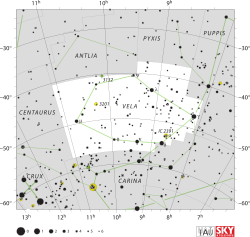HD 91324
| HD 91324 | |
 | |
| Observationsdata Epok: J2000.0 | |
|---|---|
| Stjärnbild | Seglet |
| Rektascension | 10t 31m 21,82130s[1] |
| Deklination | -53° 42′ 55,7373″[1] |
| Skenbar magnitud () | +4,89 (V)[2] |
| Stjärntyp | |
| Spektraltyp | F9 V Fe-0.8 CH-0.7[3] |
| B–V | +0,500 ± 0,015[2] |
| Astrometri | |
| Radialhastighet () | +21,37 ± 0,20[1] km/s |
| Egenrörelse (µ) | RA: -420,131[1] mas/år Dek.: +209,450[1] mas/år |
| Parallax () | 45,6124 ± 0,1682[1] |
| Avstånd | 71,5 ± 0,3 lå (21,92 ± 0,08 pc) |
| Absolut magnitud () | 3,20[2] |
| Detaljer | |
| Massa | 1,18[4] M☉ |
| Radie | 1,86 ± 0,06[4] R☉ |
| Luminositet | 4,55[2] L☉ |
| Temperatur | 6 127 ± 70[4] K |
| Metallicitet | -0,27 ± 0,06 (Fe/H)[4] dex |
| Vinkelhastighet | 8,8 ± 0,6[4] km/s |
| Ålder | 3,52 ± 1,08[5] miljarder år |
| Andra beteckningar | |
| CCDM J10314-5343A, CD-53 3569, CPD-53 3909, GJ 9332 GJ 397.2, HD 91324, HIC 51523, HIP 51523, HR 4134, IRAS 10293-5327, 2MASS J10312180-5342556, NLTT 24602, PLX 2468, PPM 339127, SAO 238146, TD1 14930, TYC 8601-4516-1, uvby98 100091324 A, WDS J10314-5343A, WISEA J103121.36-534253.4, Gaia DR2 5357075947704733568, Gaia DR1 5357075943384246528 [6][7] | |
HD 91324 är en trolig dubbelstjärna[4] belägen i den södra delen av stjärnbilden Seglet. Den har en skenbar magnitud av ca 4,89[2] och är svagt synlig för blotta ögat där ljusföroreningar ej förekommer. Baserat på parallax enligt Gaia Data Release 2 på ca 45,6[1] mas, beräknas den befinna sig på ett avstånd på ca 72 ljusår (ca 22 parsek) från solen. Den rör sig bort från solen med en heliocentrisk radialhastighet på ca 21 km/s.[1]
Egenskaper
[redigera | redigera wikitext]Primärstjärnan HD 91324 A är en metallsvag[8] gul till vit stjärna i huvudserien av spektralklass F9 V Fe-0.8 CH-0.7[3] där suffixnoten anger underskott av järn och cyan i dess spektrum. Den har en massa som är ca 1,2[4] solmassor, en radie som är ca 1,9[5] solradier och har ca 4,6 gånger solens utstrålning av energi[2] från dess fotosfär vid en effektiv temperatur av ca 6 100 K.[4]
En svag stjärna betecknad 2MASS J10313234–5338010[9] har visat sig vara en möjlig följeslagare till HD 91324 genom en rörelsesstudie som kombinerar data från Two Micron All-Sky Survey och rymdteleskopet WISE. Den beräknade separeringen av de två stjärnorna är 309 bågsekunder eller 6 700 AE. Mätningar av egenrörelse för de två stjärnorna är nästan identiska, vilket gör HD 91324 till en trolig dubbelstjärna. Fotometri av 2MASS J10313234-5338010 tyder på att den är en röd dvärg av spektraltyp M5 eller M6.[10]
Referenser
[redigera | redigera wikitext]- Den här artikeln är helt eller delvis baserad på material från engelskspråkiga Wikipedia, HD 91324, 4 januari 2021.
Noter
[redigera | redigera wikitext]- ^ [a b c d e f g h] Brown, A. G. A.; et al. (Gaia collaboration) (August 2018). "Gaia Data Release 2: Summary of the contents and survey properties". Astronomy & Astrophysics. 616. A1. arXiv:1804.09365. Bibcode:2018A&A...616A...1G. doi:10.1051/0004-6361/201833051. Gaia DR2 record for this source at VizieR.
- ^ [a b c d e f] Anderson, E.; Francis, Ch. (2012), "XHIP: An extended hipparcos compilation", Astronomy Letters, 38 (5): 331, arXiv:1108.4971, Bibcode:2012AstL...38..331A, doi:10.1134/S1063773712050015.
- ^ [a b] Gray, R. O.; et al. (2006), "Contributions to the Nearby Stars (NStars) Project: Spectroscopy of Stars Earlier than M0 within 40 pc-The Southern Sample", The Astronomical Journal, 132: 161–170, arXiv:astro-ph/0603770, Bibcode:2006AJ....132..161G, doi:10.1086/504637.
- ^ [a b c d e f g h] Fuhrmann, K.; et al. (February 2017), "Multiplicity among Solar-type Stars", The Astrophysical Journal, 836 (1): 23, Bibcode:2017ApJ...836..139F, doi:10.3847/1538-4357/836/1/139, 139.
- ^ [a b] Pace, G. (March 2013), "Chromospheric activity as age indicator. An L-shaped chromospheric-activity versus age diagram", Astronomy & Astrophysics, 551: 4, arXiv:1301.5651, Bibcode:2013A&A...551L...8P, doi:10.1051/0004-6361/201220364, L8.
- ^ http://simbad.u-strasbg.fr/simbad/sim-id?Ident=HD+91324 |Hämtad 2021-01-04.
- ^ "HD 91324". SIMBAD. Centre de données astronomiques de Strasbourg. Hämtad 2018-08-13.
- ^ da Silva, L. (July 1975), "The study of HR 3018, HD 91324 and alpha Crv and its implication for the age-abundance correlation of the neighbour stars", Astronomy and Astrophysics, 41: 287–300, Bibcode:1975A&A....41..287D.
- ^ "2MASS J10313234-5338010". SIMBAD. Centre de données astronomiques de Strasbourg. Retrieved 2018-08-13.
- ^ Luhman, Kevin L.; et al. (2012), "New M, L, and T Dwarf Companions to Nearby Stars from the Wide-field Infrared Survey Explorer", The Astrophysical Journal, 760 (2), 152, arXiv:1211.3977, Bibcode:2012ApJ...760..152L, doi:10.1088/0004-637X/760/2/152.
Externa länkar
[redigera | redigera wikitext]
| ||||||||||||||||
Text is available under the CC BY-SA 4.0 license; additional terms may apply.
Images, videos and audio are available under their respective licenses.





